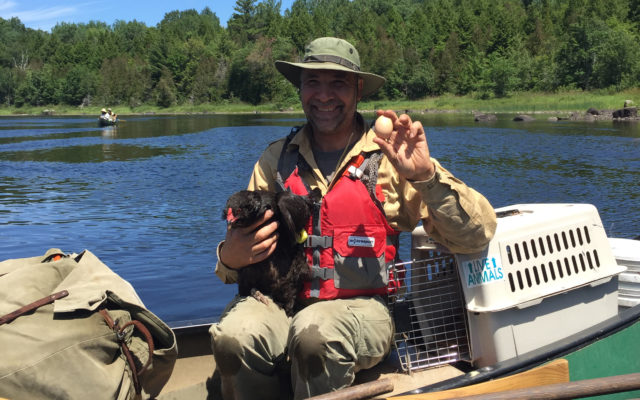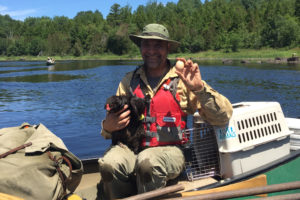
A Maine guide spent the summer canoeing with his pet chicken
Master Maine Guide Dan Pelletier has been exploring Maine waterways since his first long-distance canoe trip, a month on the Allagash Waterway, in 1986. Over the years, he’s experimented with how to make his wilderness excursions more enjoyable and interesting. And this year’s experiment may surpass all others in oddity.
This summer, Pelletier tried canoeing and camping with a live chicken.
“I’d never heard of it before,” said Pelletier, who lives in Alton and has guided trips on waterways all over the state. “I don’t know anybody who’s ever done that, and when people see me [on the water] with the chicken or hear about it, they find it pretty amusing.”

Photo courtesy of Dan Pelletier
Master Maine Guide Dan Pelletier holds up an egg his chicken, Georgia, laid while accompanying him on a five-day canoe trip on the St. Croix in July.
His initial reason was practical. A chicken could supply fresh eggs for a variety of meals, including baked goods. The idea also interested him because it was simply something new to try.
Packing his black Ameraucana chicken named Georgia into a large plastic pet crate, he set off for a five-day trial run down the St. Croix River in July, joined by a small group of friends.
“You can’t do it with just any chicken,” he said. “This one is pretty well socialized and likes people. She just hangs out. She wasn’t stressed out there or anything like that.”
Prior to the trip, Pelleteir purchased a harness made specifically for chickens, which would make it easier for him to handle the bird. At campsites, he planned to tie Georgia on a line that was fixed to a tree or picnic table, limiting where she could roam, but he quickly decided against that.
“Chickens don’t like that,” Pelletier said. “[Besides] she stays right in the campsite and goes into the crate by herself.”
The cooperative chicken adapted to life on the water pretty quickly, he said. In the canoe, she was secure in a plastic pet crate, where she’d often lay eggs. At campsites, she’d be let out of the crate to stretch her legs and forage.
“She was a lot easier to take care of than I thought,” Pelletier said. “You don’t have to feed them much because if you’re in a new site, there’s all sorts of bugs and things that chickens eat.”
The experiment went so well that Pelletier decided to take Georgia on a second trip. At the end of August and into September, Pelletier spent two weeks canoeing and camping on Lobster Lake with his 6-year-old son, Danny, their 16-year-old Australian shepherd, Aggie, and — of course — his chicken, Georgia.
Throughout the trip, they collected fewer than a dozen eggs from the chicken — not as many as they were hoping for. But the chicken could have laid some eggs in the forest around their campsite when they weren’t paying attention, Pelletier said.
With the eggs, the father-son pair made boiled and fried eggs, French toast and brownies.
“I hate to say it, but worse comes to worse, if she doesn’t put out eggs, then we could have a chicken dinner,” he said, with a laugh. “Actually, my son would probably be upset, so I probably wouldn’t.”
Though Pelletier didn’t anticipate it, Georgia quickly transitioned from poultry to pet during their trip. His son, Danny, would often play with the bird and pet it. He also assumed some responsibility for feeding it, since they did bring chicken feed along to supplement the bird’s foraging.
“I didn’t bring it as a pet, per say,” he said. “I have a dog. But it did work out that way. It ended up being a companion pet for my son. I’ve had chickens before, but I haven’t really socialized with them. They’re more friendly of a pet than you’d think — at least I thought so. They do have a personality.”
Most of the time, they allowed the chicken to walk freely, though they secured an 8-foot cord on her harness that trailed behind her. This made it much easier to spot and catch her. With black feathers, she could easily blend into the forest.
As Georgia became more comfortable with their lakefront campsite, she began to explore more, but she never went far.
“When I’d go to the outhouse, she’d kind of follow me out and back,” Pelletier said. “She didn’t wander very much.”
A ranger stopped by while conducting her usual rounds of the public lands campsites on Lobster Lake, and she was surprised about their feathered camping companion.
“That was the first time she saw a chicken at her campsite,” he said. “They didn’t have any rules against it.”
Sometimes Georgia would venture out onto a sandy beach near their campsite. Out in the open, the bird was more vulnerable to predators like bald eagles and owls. Luckily she wasn’t carried away, Pelleteir said.
Through the experience, Pelleteir learned that chickens make great canoe-camping companions. But they may not be suitable for every canoe trip, he said. He wouldn’t want to bring a chicken on a trip that involves long days on the water and short stays at camp.
“You don’t want it to be in the crate all day long, and then in the crate all night long,” he said.
Chickens are best for long canoe-camping trips that involve short days on the water and an abundance of time spent at camp, like his two-week exploration of Lobster Lake. This allows the chicken plenty of time to walk around and forage, which he thinks makes the bird easier to capture and place back in the crate at night and for canoeing.
Pelletier said he’d definitely do it again.
“I thought it’d be something interesting for us — not just for my son, but for me, too,” said Pelletier. “I expected some more action or drama from it, but I guess you could say it was just a chicken hanging out with us.”